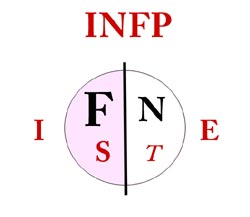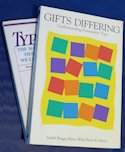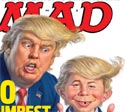
- About the MBTI
- Verify Your MBTI Type
- Personality Patterns
- MBTI Articles & Resources
- Article Directory for Educators & Students
- Books on Personality Types
- Emotional Intelligence & Personality Type
- Career Planning & MBTI
- MBTI Business Applications
- Lenore Thomson - Carl Jung Personality Type
- Site Map - Master Directory of All Articles
- MBTI Consultant Links
- Personality Type Workshops & Conferences
- Links to Other Type Websites
- Murder Mystery Business Theatre
- About Us
Building Blocks of Personality Type
by Leona Haas and Mark Hunziker
Review and comments by Ross Reinhold
In the community of educators and serious students of Myers-Briggs personality type, interest has grown in presenting personality type in a new way, departing from the traditional method of examining the four preference dichotomies that are a part of the MBTI ® four letter type code for the 16 personality types (INFP, ESTJ, ISFP, etc.). Haas and Hunziker’s latest book, Building Blocks of Personality Type, is an example of this new trend that puts the focus on eight fundamental mental processes that are derived from the work of Carl Jung, the psychologist-therapist whose work inspired Isabel Myers and her mother, Katherine Briggs, and eventually lead to the development of the MBTI ®.
While the book contains a well-written introduction to the MBTI inventory, it does so by way of connecting that well known model of explaining personality type to the “new” concept of focusing on what Haas and Hunziker term as the “Eight Jungian Mental Processes.”
I like the new concept, yet for some people newly investigating Myers Briggs or Personality Type it may be too much of a stretch to grasp both the traditional MBTI/Myers-Briggs presentation of Personality Type and the "new" model. On the other hand, I expect serious students of Jungian theory and people already familiar with the basics who want to explore personality type in more depth will find this a useful extension of Briggs-Myers and Jung. I think it also will appeal to professional practitioners (therapists, coaches, educators, etc.) who are using personality type and/or the MBTI in their professional practices. These will find the book a useful reference in better serving or educating their clients. I particularly liked the detailed examples and lists of attributes for each of the eight mental processes. Given my impression of who will most enjoy this book, my emphasis here will be reviewing aspects most relevant to practitioners.
About Building Blocks of Personality
A problem with Traditional Type Descriptions.
Haas and Hunziker note the popularity of generic descriptive profiles of the 16 personality types. They point out that these descriptions focus on traits and behaviors that are tied to only two of the eight mental processes, a type’s dominant and its auxiliary processes or preferences. While a helpful starting point to begin to grasp the differences among the types, it can also set the new learner off on the wrong path - over-generalizing and building stereotypical ideas about the natures of others and missing the dynamics of how all eight mental functions operate in all people. The traditional Myers-Briggs type code is a useful starting place. But the authors believe it is important to move the learner into understanding the “eight-process” model to more fully grasp the “richness of insight, and from there, to continue to build and expand the scope of how we view and teach type.” (page 3).
Looking at the parts and pieces of personality versus the gestalt view of the whole of personality has long been a dilemma in understanding the psychology of personality. Jung’s model of psychological types favored the looking at the whole of personality versus the pieces. While the pieces are important the notion of psychological types is that the pieces are organized into distinctive patterns that we have come to know as the 16 types of personality described by the Myers and Briggs model and “type indicator” instrument - the MBTI. Yet despite this emphasis on the whole, it is instructive to look at the parts and how they interact.
Missing Letters in the Type Code
 |
 |
Unfortunately, the letters of the type code can lead us to only looking at some parts of the whole and getting a distorted view of the whole of the personality type. For example when looking at the INFP personality type it is natural to look at the four parts suggested by the code letters: Introverted, iNtuitive, Feeling, and Perception. While these are four important parts of the whole, too often absent from the discussion is how the four hidden letters (E,S,T, & J) are also employed by this type, as if a person of this type did not have an Extraverted, Sensing, Thinking, or Judging part to their nature. (I’ve touched upon this subject at more length in my article on the hidden letters of personality type)
The Eight Primary Mental Processes
In their presentation Haas and Hunziker illustrate how the eight mental processes (Introverted Feeling, Extraverted Feeling, Introverted Intuition, Extraverted Intuition , Extraverted Thinking , Introverted Thinking, Extraverted Sensing, and Introverted Sensing) overlay or underpin the Myers typology of the 16 types. In this new way of looking at the types, the INFP type is portrayed with a dominant process of Introverted Feeling (Fi), supported by an extraverted process of Extraverted Intuition (Ne). Providing additional balance to the INFP personality pattern are Introverted Sensing and Extraverted Thinking.
After making the linkage between the two ways of looking at the components (or building blocks) of each personality type (the traditional Myers type code and the eight-process model), Haas and Hunziker then devote an entire chapter to each of the eight Jungian mental processes. Each of these eight processes will be the dominant mental process for two Myers-Briggs types and will be the auxiliary or supporting process for two other Myers-Briggs types. Each chapter contains a detailed list of important characteristics of each mental process organized under sub-headings:
Key Features
What’s Going On?
From the Outside, Looking In
Contributions
From the Inside
Vignettes
Gifts
These eight chapters are the most comprehensive descriptions of these processes that I’ve run across. The material in each chapter will be of great aid in better understanding the nature of the two Myers-Briggs personalities who share a common mental process as their dominant mental process. They will also help the reader better understand other types, who for whatever reason might be operating under or in the grip of that particular mental process. Most useful would be to the two other types for which the mental process is the person’s supporting or auxiliary. It is beyond the scope of this review to go into detail on these eight processes that Hunziker and Haas thoroughly describe, but the reader can get a basic understanding in my own article on understanding the eight mental processes.)
For practitioners who are assisting a client in the journey of understanding his or her true type identity, the material in these chapters would be invaluable. I think they would also be a useful resource for the workshop presenter to mine in preparation for presenting a program on these eight mental processes.
The Eight-Process Model of Type
Drawing upon the work of John Beebe (and others) Hunziker and Haas present the 16 personality types in a more comprehensive fashion by employing a distinctive pattern for each of the 16 types that uses all eight mental processes: Introverted Feeling (Fi), Extraverted Feeling (Fe), Introverted Intuition (Ni), Extraverted Intuition (Ne), Extraverted Thinking (Te), Introverted Thinking (Ti), Extraverted Sensing (Se), and Introverted Sensing (Si). For each type the eight processes align in a unique hierarchy. For example for the INFP personality type it would be Fi, Ne, Si, Te, Fe, Ni, Se, and Ti. (The hierarchy for all 16 types is shown in a chart near the bottom of my article on the Faces of Personality Type or click here for a pop-up window of this chart).
While there is a hierarchy of the eight mental processes for each type, Haas and Hunziker attempt to explain what this signifies (and what it does not) as care must be taken to properly parse the meaning of this term to how it applies to personality type patterns. The hierarchy illustrates a typical pattern of growth for each of the types. In my INFP example:
-
Introverted Feeling (Fi), would be developed first and first come under conscious awareness and control.
-
Extraverted Intuition (Ne) would be next in the developmental sequence,
-
followed by Introverted Sensing, (Si), and so on down the line.
At the bottom of the hierarchy (Se and Ti) are the processes that in the typical INFP would be most unconscious and most undeveloped. But that doesn’t mean they are absent or don’t play a role in the INFP personality.
So while this is the pattern for an INFP personality type, there is a “but” (no suprise, eh?). Not every INFP will follow this developmental pattern. Personality is determined by nature and nurture, not nature alone. A person’s life experiences from the moment of birth can impact the developmental route each person follows so the typical pattern of development for a given person may not always follow the “genetic” pattern of his or her type.
While I doubt many INFPs will fail to respond to the primacy of their dominant Introverted Feeling you might find circumstances where their Extraverted Thinking is developed earlier and in more conscious awareness. Having an ESTJ parent could be one of these circumstances. Another might be in an early school environment where “critical thinking” skills were emphasized. So the hierarchal pattern of type is a pre-disposition but not an iron-clad rule that must be followed.
Jungian Theorist John Beebe
If you’ve heard of John Beebe and are curious to learn more about his theories, Haas and Hunziker provide a brief introduction to his model that integrates Jungian concepts in a way that is consistent with the more conventional Myers-Briggs model of the 16 personality types. In a nutshell, Beebe has developed a set of eight archetypes that correspond to the eight mental processes that Haas and Hunziker emphasize in their book. Beebe postulates that each of these archetypes are active in every person, with one of these eight archetypes taking the lead in governing a person’s behavior depending on the circumstances. The idea of a hierarchy of the eight mental processes, as noted earlier, came from Beebe’s work with these eight archetypes. The authors indicate it is beyond the scope of their book to go into more depth into this theory of archetypes while briefly noting that “. . . the first four archetypes carry connotations primarily of the supportive and positive roles that conscious processes tend to play, while the other four processes are associated with more negative representations.” (p. 121)
Final Chapters and Appendix
The final chapters in the book provide useful ideas on applying the eight-process model to a number of practical applications: conflict management, decision-making, communication, managing change and transition, parenting and education, and career development. As I mentioned earlier I think this material is most helpful to the practitioner who uses personality type in his or her professional practice. The appendixes are in my view almost as valuable as the main content in the book. They provide a nice overview of Jung’s Model of the Psyche and an introduction to Beebe’s Archetypal model (Appendix B and Appendix G). I also liked the introduction to Harold Grant’s developmental timetable. For those who like the thumbnail descriptions of the 16 types, Appendix D contains portraits developed by Haas and Hunziker. Appendix F has nice little tables concisely contrasting the extraverted and introverted versions of the mental processes. A few other nice tidbits exist in these Appendixes and the Glossary of terms is a nice touch. Together in these last 45 pages, after the regular content, is packed a very nice package of quite useful material. Were I still in active practice I’d be stealing a number of these tidbits to incorporate into my own material!! ![]()
Ross Reinhold, July, 2012
Building Blocks of Personality Type: A Guide to Discovering the Hidden Secrets of the Personality Type Code
|
|
Personality Type In Depth |
® MBTI, Myers-Briggs, Meyers Briggs, and Myers-Briggs Type Indicator are registered trademarks or trademarks of the Myers-Briggs Type Indicator Trust in the United States and other countries (aka meyer briggs or myers briggs or briggs myers).
Return to MBTI & Myers Briggs Personality Types Home Page |
The MBTI Personality Type of Donald Trump - looking behind the media mask of The Donald.
More Popular Articles on Personality Type |
Learning about the Dynamics of Myers Briggs Personality Types. |
© Published by Ross Reinhold & Reinhold Development 1997 - 2023
Privacy Policy About Us



